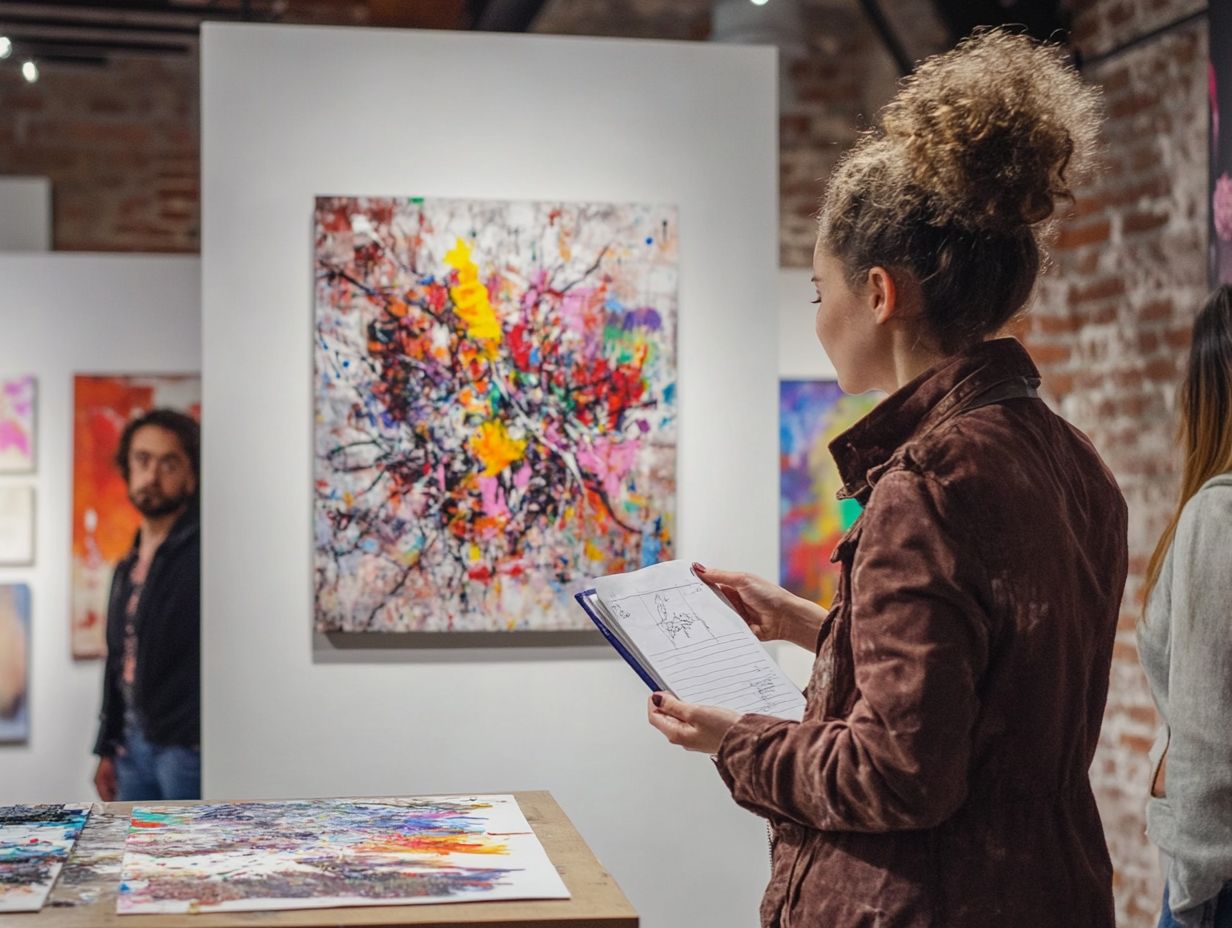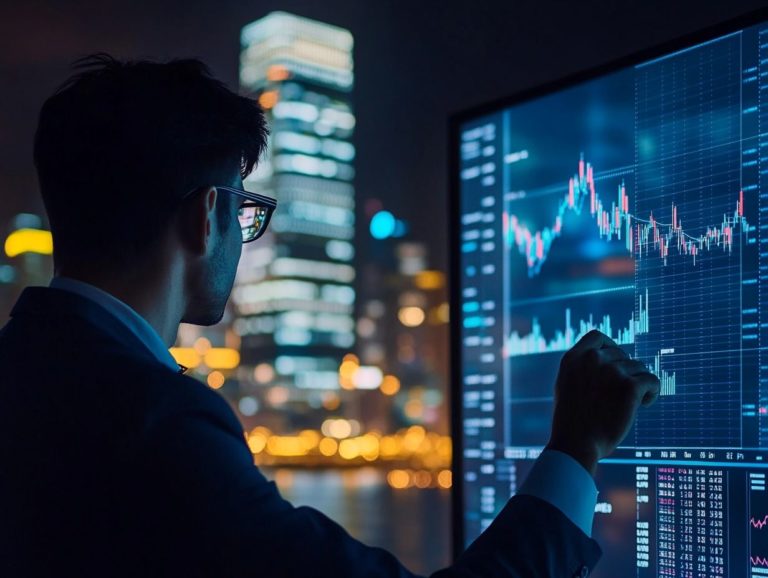Strategies for Reducing Risk in Art Investments
Investing in art can be an exhilarating journey, yet it carries its own unique risks that you should fully grasp.
From market fluctuations to the reputations of individual artists, various factors can significantly influence the value of artwork. This article delves into the different types of risks associated with art investments, examines the key elements that can affect these risks, and provides practical strategies for mitigating them.
Whether you re a seasoned collector or just starting out, understanding how to navigate the art market landscape is essential for making informed decisions.
Explore the insights within to enhance your art investment experience while minimizing potential pitfalls.
Contents
Key Takeaways:

Diversify your art investment portfolio to reduce risk and increase potential returns. It’s crucial to include a mix of different types of artwork, artists, and market trends, as well as understanding the risks of art investments.
Thoroughly research and analyze potential art investments before making a purchase. Consider factors such as the artist’s track record, market demand, and economic trends.
Work with experienced advisors who have knowledge and expertise in the art market to minimize risk and make informed investment decisions.
Understanding Art Investment Risk
Grasping the exciting nuances of art investment risk is vital for wealthy individuals like you, especially if you’re considering diversifying your portfolio with this intriguing alternative asset class.
The art market has garnered substantial attention in recent years, prompting many investors to explore the promising potential for financial growth through art appreciation.
It’s crucial to remember that, much like any investment, art carries its own unique risks that can influence returns, liquidity, and the overall performance of your art portfolio.
Engaging in art investing demands a deep comprehension of the distinctive challenges and opportunities offered by this dynamic industry.
Types of Risk in Art Investments
Art investments carry various risks that can significantly impact your financial returns as a collector or investor. Understanding these risks is essential for making informed decisions.
For instance, market risks relate to fluctuations in demand, influenced by trends and economic conditions. A well-regarded contemporary piece might command a premium during a booming market, but its value could plunge during a downturn.
Then there’s liquidity risk, which highlights the challenge of selling art quickly when needed. Not every artwork will attract buyers at all times, particularly niche pieces from lesser-known artists.
Valuation risk is another important factor. Accurately assessing an artwork’s worth is critical; overvaluation can lead to significant losses should the market correct itself.
Imagine you own a painting by an emerging artist. While the potential for substantial appreciation exists, the uncertainty around the artist’s future popularity creates a unique challenge for your investment strategy.
Factors that Influence Art Investment Risk

Several factors shape the risk linked to art investments, encompassing market trends and economic conditions that dictate art performance and its perceived investment potential.
In the dynamic world of art investing, grasping these influences is essential for wealthy individuals aiming to allocate their wealth judiciously and safeguard their assets against inflation.
With the emergence of digital art and platforms like Masterworks and NFTs, traditional concepts of art valuation and appraisal are undergoing a transformation, presenting both intriguing opportunities and formidable challenges for savvy investors like you.
Start your art investment journey today and discover the treasures waiting for you!
Market Trends and Economic Factors
Market trends and economic factors are crucial in shaping your art investment landscape. They influence everything from auction house sales to the overall vitality of the art market.
During periods of economic uncertainty, you may notice fluctuations in demand for art funds. Investors like yourself reassess risk tolerance and liquidity needs.
As traditional markets become unstable, some collectors might look to art as a way to protect value when prices rise. Others could be put off by the perceived risks tied to high-value artworks and auction houses.
This creates a complex environment where you, as a savvy investor, need to carefully evaluate both the timing and selection of artworks. Understanding these trends is essential for seizing potential gains and reducing the inherent risks that come with art investment ventures.
Understanding Artist Impact on Value
The significance of an artist and their artwork plays a pivotal role in shaping investment risk and value within the art market. This influence arises not just from the artist’s reputation but also from their historical importance within the broader tapestry of art movements and cultural narratives.
As you evaluate pieces for potential acquisition, it’s essential to consider the emotional connections that resonate with audiences. These connections can significantly enhance or diminish an artwork’s allure.
Conducting thorough art appraisals becomes vital. It offers insights that enable you to make informed decisions about which pieces to integrate into your portfolio.
Navigating the intricacies of art valuation and market dynamics is crucial for effective portfolio management. By doing so, you ensure that your acquisitions align with both your passion for art and your strategic foresight.
Strategies for Reducing Art Investment Risk

You must implement smart strategies today to reduce art investment risk and protect your assets! For high net worth individuals like yourself, understanding the role of art in alternative investment strategies is essential for making well-considered choices.
By diversifying your art portfolio, you can effectively mitigate the potential downsides of market fluctuations. Thorough research and analysis of prospective investments can reveal hidden opportunities in both the physical and digital art markets.
Consulting with experienced advisors can refine your strategic approach to art investing. This ensures your investment decisions are solidly grounded.
Diversifying Your Portfolio
Diversifying your portfolio within the art investing realm is not just a smart move; it s essential for reducing risks and enhancing the potential of your art assets.
By allocating funds across various styles, periods, and types of art, you broaden your exposure to unique market dynamics. This strategy enables you to capitalize on emerging trends while safeguarding against market volatility.
Incorporating alternative asset classes, such as contemporary, modern, or even digital art, can create a more balanced portfolio. As the art market continues to evolve, embracing a diverse range of artistic expressions can significantly enhance your overall investment performance.
Thus, diversification becomes not merely an option, but a necessity for discerning investors like yourself. Start diversifying your art portfolio now to secure your investments!
Researching and Analyzing Potential Investments
Thorough research and analysis of potential investments are essential for making informed decisions in the art industry. This is especially important given the ever-fluctuating market trends.
You should delve into the histories of artworks and the backgrounds of the artists. These elements significantly influence value.
Understanding previous auction results and current market dynamics aids in accurate valuations. It also equips you with the insights needed to navigate the complexities of the art world.
By emphasizing rigorous valuation techniques, you can illuminate the potential returns of an investment. This strategic approach ensures that your decisions are rooted in data, ultimately enhancing your chances of success in an ever-evolving landscape.
Working with Experienced Advisors

Collaborating with seasoned advisors in art investing can elevate your investment strategies.
They understand art funds and valuation techniques, helping them handle the complexities of the market.
By tapping into their insights, you can uncover undervalued artworks and emerging trends, paving the way for substantial financial growth over time.
These professionals excel in assessing market dynamics, allowing them to identify potential risks before they escalate.
This approach reduces investment risks and creates a more rewarding journey for those who choose to partner with them.
Long-Term vs. Short-Term Investment Approaches
The debate surrounding long-term versus short-term investment strategies in art investing is crucial for high net worth individuals like you who aim to maximize financial growth in the art market.
Each strategy carries distinct advantages and risks. Long-term investments typically focus on curating an art portfolio that appreciates significantly, while short-term investments allow you to seize trends and opportunities within the ever-evolving art landscape.
By grasping the subtleties of both approaches, you can make well-informed decisions tailored to your unique goals and risk tolerance.
Pros and Cons of Each Strategy
Understanding the pros and cons of both long-term and short-term investment strategies is essential for making informed decisions in the art market.
Long-term strategies focus on appreciating artworks over several years, aiming for significant value jumps that could boost your portfolio based on market trends, artist reputation, and historical significance.
This method allows you to potentially weather market fluctuations with more ease.
On the flip side, short-term strategies capitalize on current market demands for quick returns. However, this approach comes with heightened risks, including volatility.
For instance, you might snag immediate gains by purchasing contemporary works from emerging artists, but there’s also the chance of losses if those artists lose their appeal.
Thus, understanding how these strategies impact art performance and liquidity can play a pivotal role in your financial planning.
Frequently Asked Questions
What are some common strategies for reducing risk in art investments?
Common strategies include:
- Diversifying your portfolio
- Conducting thorough research on the artwork and artist
- Purchasing from reputable galleries or auction houses
How does diversifying your art portfolio help reduce risk?
By investing in various artists and styles, you can minimize the impact of any single investment’s poor performance.
Why is conducting research important when considering an art investment?
Research provides valuable insights into the potential value and marketability of a piece and helps identify any risks associated with the investment.
What are some ways to mitigate the risk of forgeries in art investments?
Some ways include:
- Purchasing from reputable sources
- Requesting certificates of authenticity
- Having the artwork authenticated by a professional
Are there any strategies specifically for reducing financial risk in art investments?
Yes, strategies include:
- Setting a budget and sticking to it
- Considering the potential resale value of the artwork
- Getting insurance coverage for your art collection
Why is it important to stay informed about the art market when making investments?
Staying informed helps you make better investment decisions and identify market changes or trends that may affect the value of your investments.






